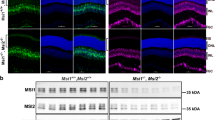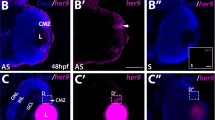Abstract
Drosophila photoreceptor neurons (R cells) project their axons to one of two layers in the optic lobe, the lamina or the medulla. The transcription factor Runt (Run) is normally expressed in the two inner R cells (R7 and R8) that project their axons to the medulla. Here we examine the relationship between Run and the ubiquitously expressed nuclear protein Brakeless (Bks), which has previously been shown to be important for axon termination in the lamina. We report that Bks represses Run in two of the outer R cells: R2 and R5. Expression of Run in R2 and R5 causes axonal mistargeting of all six outer R cells (R1–R6) to the inappropriate layer, without altering expression of cell-specific developmental markers.
This is a preview of subscription content, access via your institution
Access options
Subscribe to this journal
Receive 12 print issues and online access
$209.00 per year
only $17.42 per issue
Buy this article
- Purchase on Springer Link
- Instant access to full article PDF
Prices may be subject to local taxes which are calculated during checkout




Similar content being viewed by others
References
Chisholm, A. & Tessier-Lavigne, M. Conservation and divergence of axon guidance mechanisms. Curr. Opin. Neurobiol. 9, 603–615 (1999).
Tessier-Lavigne, M. & Goodman, C.S. The molecular biology of axon guidance. Science 274, 1123–1133 (1996).
Goodman, C.S. & Shatz, C.J. Developmental mechanisms that generate precise patterns of neuronal connectivity. Cell 72 (Suppl.), 77–98 (1993).
Schmucker, D. & Zipursky, S.L. Signaling downstream of Eph receptors and ephrin ligands. Cell 105, 701–704 (2001).
Stoker, A.W. Receptor tyrosine phosphatases in axon growth and guidance. Curr. Opin. Neurobiol. 11, 95–102 (2001).
Newsome, T.P. et al. Trio combines with dock to regulate Pak activity during photoreceptor axon pathfinding in Drosophila. Cell 101, 283–294 (2000).
Hing, H., Xiao, J., Harden, N., Lim, L. & Zipursky, S.L. Pak functions downstream of Dock to regulate photoreceptor axon guidance in Drosophila. Cell 97, 853–863. (1999).
Klein, R. Excitatory Eph receptors and adhesive ephrin ligands. Curr. Opin. Cell Biol. 13, 196–203 (2001).
Ready, D.F., Hanson, T.E. & Benzer, S. Development of the Drosophila retina, a neurocrystalline lattice. Dev. Biol. 53, 217–240 (1976).
Senti, K., Keleman, K., Eisenhaber, F. & Dickson, B.J. Brakeless is required for lamina targeting of R1-R6 axons in the Drosophila visual system. Development 127, 2291–2301 (2000).
Rao, Y., Pang, P., Ruan, W., Gunning, D. & Zipursky, S.L. Brakeless is required for photoreceptor growth-cone targeting in Drosophila. Proc. Natl. Acad. Sci. USA 97, 5966–5971 (2000).
Kania, M.A., Bonner, A.S., Duffy, J.B. & Gergen, J.P. The Drosophila segmentation gene runt encodes a novel nuclear regulatory protein that is also expressed in the developing nervous system. Genes Dev. 4, 1701–1713 (1990).
Canon, J. & Banerjee, U. Runt and Lozenge function in Drosophila development. Semin. Cell Dev. Biol. 11, 327–336 (2000).
Speck, N.A. et al. Core-binding factor: a central player in hematopoiesis and leukemia. Cancer Res. 59, 1789s–1793s (1999).
Wijmenga, C. et al. Identification of a new murine runt domain-containing gene, Cbfa3, and localization of the human homolog, CBFA3, to chromosome 1p35-pter. Genomics 26, 611–614 (1995).
Downing, J.R. AML1/CBFbeta transcription complex: its role in normal hematopoiesis and leukemia. Leukemia 15, 664–665 (2001).
Kaminker, J.S., Singh, R., Lebestky, T., Yan, H. & Banerjee, U. Redundant function of runt domain binding partners, big-brother and brother, during Drosophila development. Development 128, 2639–2648 (2001).
Adams, M.D. et al. The genome sequence of Drosophila melanogaster. Science 287, 2185–2195 (2000).
Brand, A.H. & Perrimon, N. Targeted gene expression as a means of altering cell fates and generating dominant phenotypes. Development 118, 401–415 (1993).
Tissot, M., Gendre, N., Hawken, A., Störtkuhl, K.F. & Stocker, R.F. Larval chemosensory projections and invasion of adult afferents in the antennal lobe of Drosophila. J. Neurobiol. 32, 281–297 (1997).
Mollereau, B. et al. Two-step process for photoreceptor formation in Drosophila. Nature 412, 911–913 (2001).
Huang, Z. & Kunes, S. Hedgehog, transmitted along retinal axons, triggers neurogenesis in the developing visual centers of the Drosophila brain. Cell 86, 411–422 (1996).
Huang, Z., Shilo, B.Z. & Kunes, S. A retinal axon fascicle uses spitz, an EGF receptor ligand, to construct a synaptic cartridge in the brain of Drosophila. Cell 95, 693–703 (1998).
Perez, S.E. & Steller, H. Migration of glial cells into retinal axon target field in Drosophila melanogaster. J. Neurobiol. 30, 359–373 (1996).
Poeck, B., Fischer, S., Gunning, D., Zipursky, S.L. & Salecker, I. Glial cells mediate target layer selection of retinal axons in the developing visual system of Drosophila. Neuron 29, 99–113 (2001).
Dokucu, M.E., Zipursky, S.L. & Cagan, R.L. Atonal, rough and the resolution of proneural clusters in the developing Drosophila retina. Development 122, 4139–4147 (1996).
Frankfort, B.J., Nolo, R., Zhang, Z., Bellen, H. & Mardon, G. Senseless repression of rough is required for R8 photoreceptor differentiation in the developing Drosophila eye. Neuron 32, 403–414 (2001).
Clandinin, T.R. & Zipursky, S.L. Afferent growth cone interactions control synaptic specificity in the Drosophila visual system. Neuron 28, 427–436 (2000). [Comment in Neuron 28, 310–313 (2000).]
Campos-Ortega, J.A. & Hartenstein, V. The Embryonic Development of Drosophila melanogaster (Springer-Verlag, New York, 1997).
Meinertzhagen, I.A. in Evolution of the Eye and Visual System (eds. Cronly-Dillon, J. R. & Gregory, R. L.) 341–363 (Macmillan, London, 1991).
Erkman, L. et al. A POU domain transcription factor-dependent program regulates axon pathfinding in the vertebrate visual system. Neuron 28, 779–792 (2000).
Thor, S., Andersson, S.G., Tomlinson, A. & Thomas, J.B. A LIM-homeodomain combinatorial code for motor-neuron pathway selection. Nature 397, 76–80 (1999).
Kania, A., Johnson, R.L. & Jessell, T.M. Coordinate roles for LIM homeobox genes in directing the dorsoventral trajectory of motor axons in the vertebrate limb. Cell 102, 161–173 (2000).
Levanon, D. et al. The Runx3 transcription factor regulates development and survival of TrkC dorsal root ganglia neurons. EMBO J. (in press).
White, N.M. & Jarman, A.P. Drosophila atonal controls photoreceptor R8-specific properties and modulates both receptor tyrosine kinase and Hedgehog signaling. Development 127, 1681–1689 (2000).
Acknowledgements
We are grateful to A. Brand, R. Carthew, B. Dickson, P. Gergen, S. L. Zipursky, N. Perrimon, K. Saigo, R. Stocker, G. Rubin, K. Matthews and the Bloomington Stock Center for fly stocks and antibodies. We thank T. Clandinin, C-H. Lee, T. Herman and members of the Banerjee laboratory for thoughtful suggestions and comments. We thank L. Zipursky for helpful discussions and for supporting part of this work in his laboratory. We thank Y. Ito and his collaborators and Y. Groner and his collaborators, for communicating results prior to publication. The Rough and Dac antibodies were obtained from the University of Iowa Developmental Studies Hybridoma Bank, developed under the auspices of the National Institute of Child Health & Human Development. This work was supported by a National Institutes of Health grant (U.B.), U.S.P.H.S. National Research Service Awards (J.K. and J.C.) and the Medical Research Council (I.S.).
Author information
Authors and Affiliations
Corresponding author
Ethics declarations
Competing interests
The authors declare no competing financial interests.
Rights and permissions
About this article
Cite this article
Kaminker, J., Canon, J., Salecker, I. et al. Control of photoreceptor axon target choice by transcriptional repression of Runt. Nat Neurosci 5, 746–750 (2002). https://doi.org/10.1038/nn889
Received:
Accepted:
Published:
Issue Date:
DOI: https://doi.org/10.1038/nn889
This article is cited by
-
Temporal and spatial order of photoreceptor and glia projections into optic lobe in Drosophila
Scientific Reports (2018)
-
Temporal identity in axonal target layer recognition
Nature (2008)
-
Specification and connectivity of neuronal subtypes in the sensory lineage
Nature Reviews Neuroscience (2007)
-
Axon guidance mechanisms and molecules: lessons from invertebrates
Nature Reviews Neuroscience (2003)
-
Runx3 controls the axonal projection of proprioceptive dorsal root ganglion neurons
Nature Neuroscience (2002)



